I'grand currently working on a series of botanical illustrations and natural history drawings for Field Studies Quango, who will use them on identification charts. One of the charts details edible British plants, and includes the Dog rose,Rosa canina.
The kickoff step is to draw upward a pencil rough. I use a mechanical pencil, such as the Pentel P205, and draw directly onto watercolour newspaper. I use Fabriano Artistico hot printing paper,which has a loftier cotton fiber content, and a very well-baked and shine working surface.
It's always easiest to work from live specimens as yous tin examine them, turn them over, and put them under a magnifying drinking glass. Although it'due south autumn there are still domestic dog rose hips and leaves to work from. (It'south worth noting that foliage colour is often compromised in autumn, as the chlorophyll is less in evidence, thus allowing the yellow and cherry pigments to be more dominant).
I likewise utilize books such as David Streeter's Collins Blossom Guide, the brilliant illustrations of Stella Ross-Craig, the Hedgerow Handbook by Adele Nozedar, and my own sketchbooks for reference. (See my blog on working without specimens for more on this).
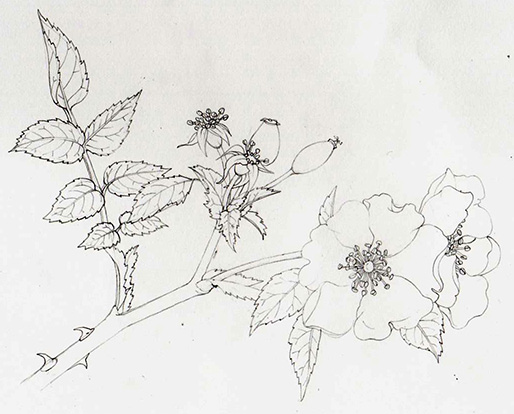
I electronic mail the rough to the client who will suggest alterations and changes where appropriate. In this case it was good to go without tweaking.
Painting the darkest areas of the leaves
First, I pigment the leaves. Mixing greens is notoriously catchy, and you should never trust a green straight from the tube or pan; they simply don't echo nature's palette. I tend to favour Winsor & Newton watercolours , and always utilise a Winsor & Newton series 7 castor as no other brushes on the market agree their tips besides. Mostly, unless doing infinitesimal hairs on stems (a 000 size castor) or a big watercolour wash (a number 2 or 4) I use a number 1 castor.
The green of the dog rose leaves is based on a hooker green light, mixed with cadmium yellow light and some yellow ochre. It also has some blue in; to be honest I don't keep a clinical eye on what colours I utilise; only will exist sure there are some warmish purple-blues and some cooler greenish-blues on the get in my paint-box. I approximate a spot of something like pthalo blue does the trick.
I block in the areas of shadow on the leaves, examining my specimen the whole fourth dimension.
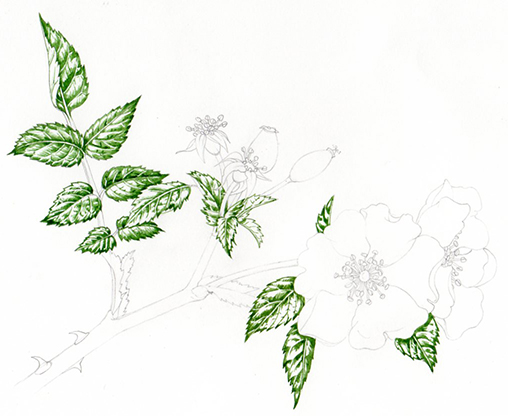
Next, I'll soften these areas by lightening the green mix, adding a little water, and a little bit more yellowish. I apply this wet mix over the expanse I've painted, ensuring that the lightest areas remain white.
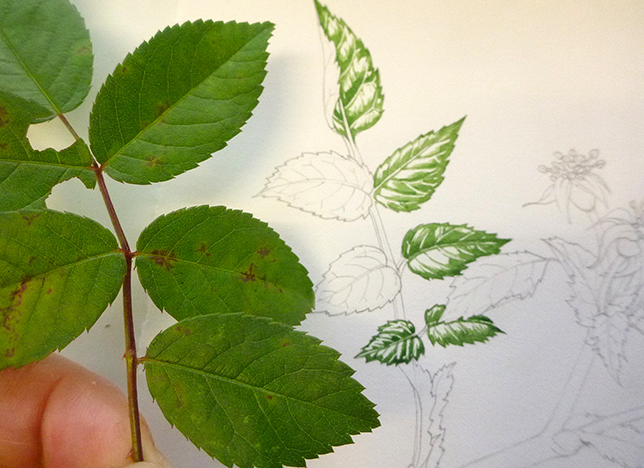
Side by side, I mix up a yellower light-green which is used between the dark areas of the leaf and the lightest regions. With a niggling more than water and perhaps more than of a dark-brown yellow (indian yellow or yellowish ochre) I also use this mix for the stems. I only paint one side of the stem, the one furthest from the light source (convention dictates this is the right hand side of the institute). Then using a watery version of the aforementioned mix I'll fill in the residue of the stalk, thus giving it some depth.
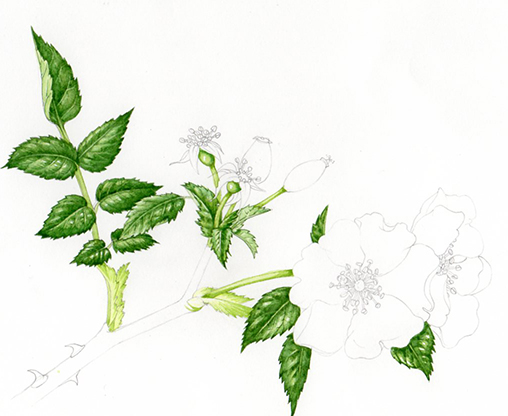
More piece of work on the leaves follows, working into the darkest areas with a mix of hooker green, pthalo blue, and a royal. This sharpens the edges such as the dentate foliage margin, and gives extra depth to the shadows.
Illustrating the rose hip
Subsequently so much dark-green, I tin't resist some ruby – the rosehips. This vibrant colour is a mix of alizarin ruby-red, opera rose (more than of which afterwards), and cadmium orange low-cal. Once again, I plot the darks first, then a brighter area, and finally an oranger and paler third layer of paint. Again, leaving the white paper to show shine and highlights is vital.
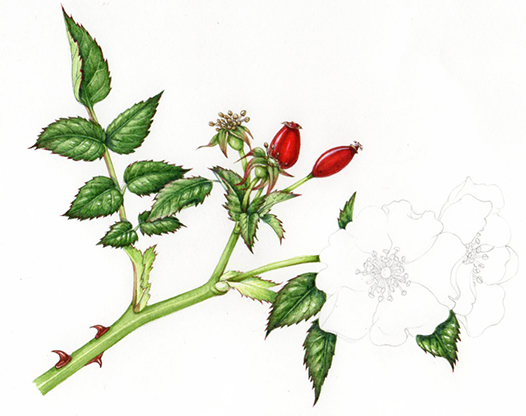
Painting the Rose petals
The petals are next. I've been driven mad in my attempts to become the colour of a dog rose correct. It's a cool pink, and in the past I've made the colour besides orange, then too blue. My third error was to mix the pinkish in with white which gives the right hue, but a thick and utterly un-petal-similar consistency and experience. Opera rose paint has been a life saver here. Watered down, mixed with the tiniest affect of cobalt blue, it provides a passable colour match. I build up the petals past painting on the veins and surrounding areas of colour with tiny repeated brush strokes.
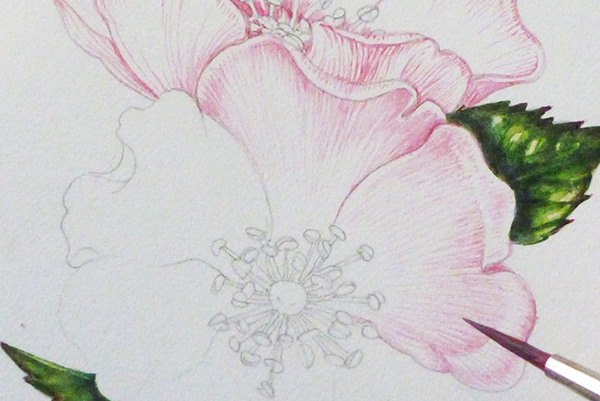
Although it's important to keep the colour of such delicate petals pale, it's as well vital to give structure to the analogy. Getting this residue right is exhausting.
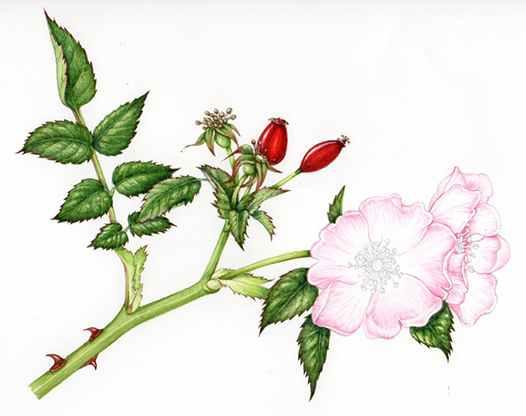
The petals cast shadows which demand to be plotted; a skilful mix for these is a watery cobalt blue mixed with a purple or violet. As the shadows are plotted you tin ensure that the two roses are clearly separated.
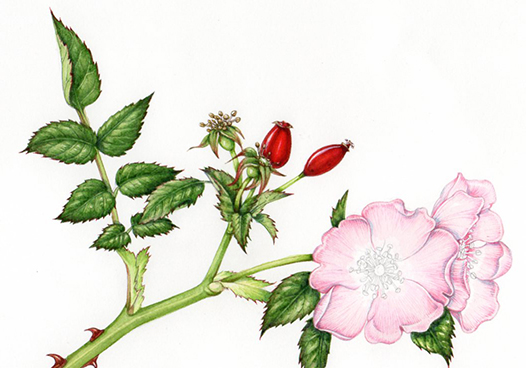
Adding the details
Last up is the anthers, stamens, and cardinal reproductive organs of the bloom. Brownish yellows ans stake greens play the principal role here. A petty more than tweaking of shadows and crisping upward the edges, this time with a violet and vandyke brown mix, and nosotros're washed.
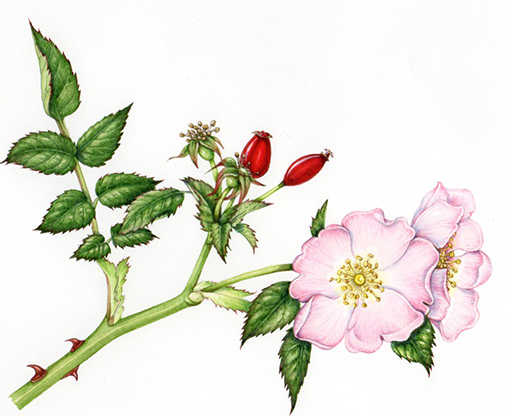
Terminate of the day
The last photo shows my desk at the end of the working solar day. There's always room for improvement with a natural history illustration. There are always areas which haven't worked too as 1 might've hoped. However, as a decent delineation of a skillful rose, for someone looking to place and eat it, I think this'll do.
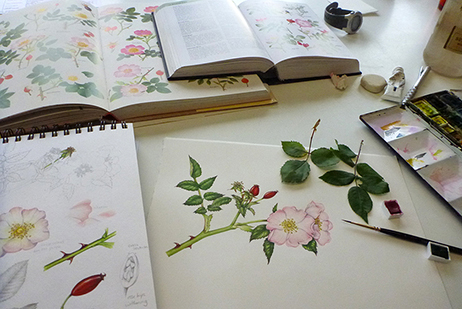
DOWNLOAD HERE
How to Draw a Dog With a Rose TUTORIAL
Posted by: cecilefolong.blogspot.com